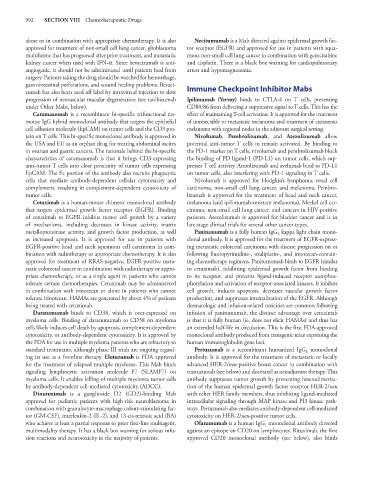Page 1006 - Basic _ Clinical Pharmacology ( PDFDrive )
P. 1006
992 SECTION VIII Chemotherapeutic Drugs
alone or in combination with appropriate chemotherapy. It is also Necitumumab is a Mab directed against epidermal growth fac-
approved for treatment of non-small cell lung cancer, glioblastoma tor receptor (EGFR) and approved for use in patients with squa-
multiforme that has progressed after prior treatment, and metastatic mous non-small cell lung cancer in combination with gemcitabine
kidney cancer when used with IFN-α. Since bevacizumab is anti- and cisplatin. There is a black box warning for cardiopulmonary
angiogenic, it should not be administered until patients heal from arrest and hypomagnesemia.
surgery. Patients taking the drug should be watched for hemorrhage,
gastrointestinal perforations, and wound healing problems. Bevaci- Immune Checkpoint Inhibitor Mabs
zumab has also been used off label by intravitreal injection to slow
progression of neovascular macular degeneration (see ranibizumab Ipilimumab (Yervoy) binds to CTLA-4 on T cells, preventing
under Other Mabs, below). CD80/86 from delivering a suppressive signal to T cells. This has the
Catumaxomab is a recombinant bi-specific trifunctional rat- effect of maintaining T-cell activation. It is approved for the treatment
mouse IgG hybrid monoclonal antibody that targets the epithelial of unresectable or metastatic melanoma and treatment of cutaneous
cell adhesion molecule (EpCAM) on tumor cells and the CD3 pro- melanoma with regional nodes in the adjuvant surgical setting.
tein on T cells. This bi-specific monoclonal antibody is approved in Nivolumab, Pembrolizumab, and Atezolizumab allow
the USA and EU as an orphan drug for treating abdominal ascites potential anti-tumor T cells to remain activated. By binding to
in ovarian and gastric cancers. The rationale behind the bi-specific the PD-1 marker on T cells, nivolumab and pembrolizumab block
characteristics of catumaxomab is that it brings CD3-expressing the binding of PD ligand-1 (PD-L1) on tumor cells, which sup-
anti-tumor T cells into close proximity of tumor cells expressing presses T cell activity. Atezolizumab and avelumab bind to PD-L1
EpCAM. The Fc portion of the antibody also recruits phagocytic on tumor cells, also interfering with PD-1 signaling in T cells.
cells that mediate antibody-dependent cellular cytotoxicity and Nivolumab is approved for Hodgkin’s lymphoma, renal cell
complement, resulting in complement-dependent cytotoxicity of carcinoma, non-small cell lung cancer, and melanoma. Pembro-
tumor cells. lizumab is approved for the treatment of head and neck cancer,
Cetuximab is a human-mouse chimeric monoclonal antibody melanoma (and ipilimumab-resistant melanoma), Merkel cell car-
that targets epidermal growth factor receptor (EGFR). Binding cinoma, non-small cell lung cancer, and cancers in HIV-positive
of cetuximab to EGFR inhibits tumor cell growth by a variety patients. Atezolizumab is approved for bladder cancer and is in
of mechanisms, including decreases in kinase activity, matrix late-stage clinical trials for several other cancer types.
metalloproteinase activity, and growth factor production, as well Panitumumab is a fully human IgG kappa light chain mono-
2
as increased apoptosis. It is approved for use in patients with clonal antibody. It is approved for the treatment of EGFR-express-
EGFR-positive head and neck squamous cell carcinoma in com- ing metastatic colorectal carcinoma with disease progression on or
bination with radiotherapy or appropriate chemotherapy. It is also following fluoropyrimidine-, oxaliplatin-, and irinotecan-contain-
approved for treatment of KRAS-negative, EGFR-positive meta- ing chemotherapy regimens. Panitumumab binds to EGFR (similar
static colorectal cancer in combination with radiotherapy or appro- to cetuximab), inhibiting epidermal growth factor from binding
priate chemotherapy, or as a single agent in patients who cannot to its receptor, and prevents ligand-induced receptor autophos-
tolerate certain chemotherapies. Cetuximab may be administered phorylation and activation of receptor-associated kinases. It inhibits
in combination with irinotecan or alone in patients who cannot cell growth, induces apoptosis, decreases vascular growth factor
tolerate irinotecan. HAMAs are generated by about 4% of patients production, and suppresses internalization of the EGFR. Although
being treated with cetuximab. dermatologic and infusion-related toxicities are common following
Daratumumab binds to CD38, which is over-expressed on infusion of panitumumab, the distinct advantage over cetuximab
myeloma cells. Binding of daratumumab to CD38 on myeloma is that it is fully human (ie, does not elicit HAMAs) and thus has
cells likely induces cell death by apoptosis, complement-dependent an extended half-life in circulation. This is the first FDA-approved
cytotoxicity, or antibody-dependent cytotoxicity. It is approved by monoclonal antibody produced from transgenic mice expressing the
the FDA for use in multiple myeloma patients who are refractory to human immunoglobulin gene loci.
standard treatments, although phase III trials are ongoing regard- Pertuzumab is a recombinant humanized IgG 1 monoclonal
ing its use as a frontline therapy. Elotuzumab is FDA approved antibody. It is approved for the treatment of metastatic or locally
for the treatment of relapsed multiple myeloma. This Mab binds advanced HER-2/neu-positive breast cancer in combination with
signaling lymphocytic activation molecule F7 (SLAMF7) on trastuzumab (see below) and docetaxel as neoadjuvant therapy. This
myeloma cells. It enables killing of multiple myeloma tumor cells antibody suppresses tumor growth by preventing heterodimeriza-
by antibody-dependent cell-mediated cytotoxicity (ADCC). tion of the human epidermal growth factor receptor HER-2/neu
Dinutuximab is a ganglioside D2 (GD2)-binding Mab with other HER family members, thus inhibiting ligand-mediated
approved for pediatric patients with high-risk neuroblastoma in intracellular signaling through MAP kinase and PI3 kinase path-
combination with granulocyte-macrophage colony-stimulating fac- ways. Pertuzumab also mediates antibody-dependent cell-mediated
tor (GM-CSF), interleukin-2 (IL-2), and 13-cis-retinoic acid (RA) cytotoxicity on HER-2/neu-positive tumor cells.
who achieve at least a partial response to prior first-line multiagent, Ofatumumab is a human IgG monoclonal antibody directed
1
multimodality therapy. It has a black box warning for serious infu- against an epitope on CD20 on lymphocytes. Rituximab, the first
sion reactions and neurotoxicity in the majority of patients. approved CD20 monoclonal antibody (see below), also binds

